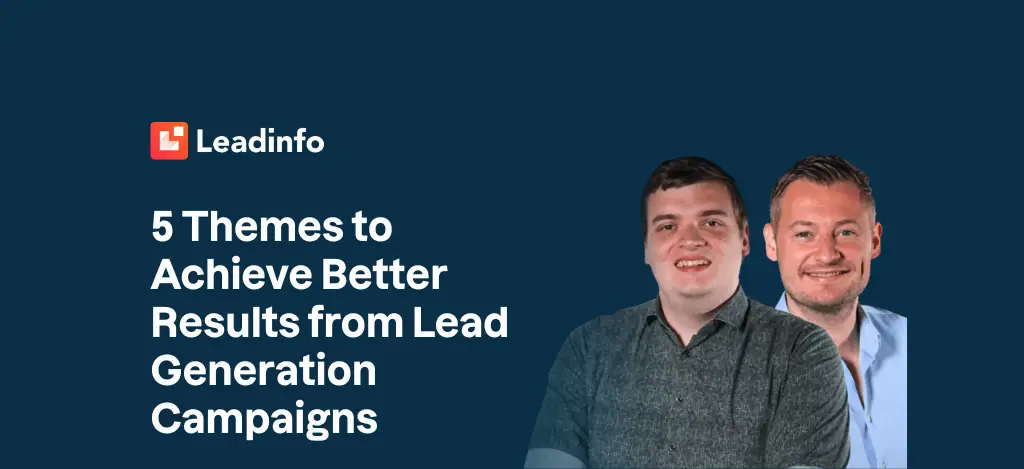Every B2B marketer knows the feeling: you launch a beautifully designed campaign, ad spend increases, yet the flow of leads falls short of expectations. In our joint webinar with Converseon Digital Agency, founders Arjan de Groot and Kevin Juffermans demonstrated that this problem rarely lies with the advertising channels themselves. The secret is in how you structure, enrich, and leverage your own first-party data to make every step of the funnel smarter. In this blog, you’ll discover five concrete pillars that will not only help you scale your lead generation, but also improve its quality.
👉 Watch the webinar here. The webinar is recorded in Dutch, but you can use the subtitle feature to transcribe the webinar to English or other languages.
1. First-party data: the hidden goldmine within your organisation
“You’re probably already sitting on a mountain of data; you just need to start mining it.”
– Arjan
Every organisation has data. But is it being used effectively? First-party data refers to all the data you’ve collected yourself, often stored in your CRM. In reality, a genuine goldmine.
Arjan and Kevin began with a simple exercise: make a list of all the data sources within your company. Think CRM records, marketing automation, Leadinfo visits, LinkedIn followers, newsletter subscriptions, and even sales or customer support notes. Many participants only realised during the webinar how much data was already available to be connected.
Example from the webinar
Converseon helped a client reactivate old quote requests from their CRM. By uploading this list as a LinkedIn audience and targeting only decision-makers within those accounts, a significant portion of the pipeline came back on the radar. The success didn’t lie in large numbers, but in the relevance of each contact.
2. Target more precisely with the BLUE-BANT method
First-party data only becomes valuable when you use it to create smart audiences. For this, Converseon uses the BLUE-BANT matrix. BLUE stands for:
- Business size
- Location
- Usage match
- Engagement history
Combined with BANT (Budget, Authority, Need, Timing), this produces a score indicating which companies have the highest potential for an effective follow-up.
In the webinar, Kevin showcased a LinkedIn campaign where a compact audience created using BLUE-BANT achieved significantly higher click and conversion rates than a broad interest-based group. Less reach, more quality, the exact outcome you want in B2B.
3. Content that resonates thanks to real-time insights from Leadinfo
Pageviews alone reveal little about who you’re reaching. That’s why Converseon filters companies daily with Leadinfo, identifying those who spend more time on knowledge articles or return repeatedly. These company names are sent to marketing, which checks in the CRM if the account is already in pipeline. If not, a personal follow-up follows.
“You don’t need to send a mass email; one relevant message is enough if you know someone has been engaging with your content.”
– Kevin
This approach sparks spontaneous conversations that would otherwise disappear into anonymity. A perfect example of successfully activating your own data.
4. Lead scoring: aligning marketing and sales
Lead scoring ensures sales teams spend their time on contacts who both fit the ideal customer profile and demonstrate active interest. Arjan showed how Converseon assigns points on two axes: Fit (static company and role characteristics) and Engagement (behaviour such as downloads or webinar attendance). Only when a predefined threshold is reached does sales receive a notification. The result: fewer handovers, but a much higher percentage of follow-up conversations, something that benefits both marketing and sales.
5. Server-side tagging: continue measuring when cookies disappear
Google Chrome will soon phase out third-party cookies, those that collect visitor data and send it to “third parties” such as Facebook or LinkedIn pixels.
Without an alternative, you risk losing a large share of your attribution data. Converseon demonstrated how server-side tagging closes this gap: an event (such as a demo request) first goes to your own server, is enriched with CRM information, and only then forwarded to platforms like LinkedIn or Google Ads. This way, you stay in control of what you share, remain GDPR-compliant, and maintain campaign measurability.
Ready to achieve better results from your lead generation campaigns?
Watch the full recording to dive deeper into these five themes.
Do you have questions about BLUE-BANT scoring, server-side tagging, or linking data sources? We’d be happy to help! Get in touch, we’re here for you.
Don’t let your competitors win with data you already own. Try Leadinfo free for 14 days, unlock your own goldmine, and start achieving better results from your lead generation campaigns today.


